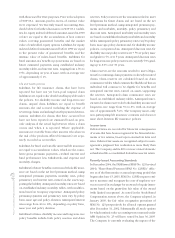American Express 2004 Annual Report Download - page 90
Download and view the complete annual report
Please find page 90 of the 2004 American Express annual report below. You can navigate through the pages in the report by either clicking on the pages listed below, or by using the keyword search tool below to find specific information within the annual report.
premiums or estimated gross profits associated with the
products depending on the product’s characteristics. For
certain mutual fund products, DAC are generally amor-
tized over fixed periods on a straight-line basis. For annu-
ity and insurance products, the projections underlying the
amortization of DAC require the use of certain assump-
tions, including interest margins, mortality and morbidity
rates, persistency rates, maintenance expense levels and
customer asset value growth rates for variable products.
Management routinely monitors a wide variety of trends
in the business, including comparisons of actual and
assumed experience. Management reviews and, where
appropriate, adjusts its assumptions with respect to cus-
tomer asset value growth rates on a quarterly basis. Man-
agement monitors other principal DAC assumptions,
such as persistency, mortality and morbidity rates, interest
margin and maintenance expense level assumptions,
each quarter. Unless management identifies a material
deviation over the course of the quarterly monitoring,
management reviews and updates these DAC assump-
tions annually in the third quarter of each year. When
assumptions are changed, the percentage of estimated
gross profits or portion of interest margins used to amor-
tize DAC may also change. A change in the required
amortization percentage is applied retrospectively; an
increase in amortization percentage will result in an accel-
eration of DAC amortization while a decrease in amorti-
zation percentage will result in a deceleration of DAC
amortization. The impact on results of operations of
changing assumptions with respect to the amortization of
DAC can be either positive or negative in any particular
period and is reflected in the period in which such
changes are made.
Land, buildings and equipment
Land, buildings and equipment
Buildings and equipment, including leasehold improve-
ments, are carried at cost less accumulated depreciation.
Costs incurred during construction, as well as related
interest, are capitalized and are depreciated once an
asset is placed in service. Depreciation is generally com-
puted using the straight-line method over the estimated
useful lives of assets, which range from three to eight
years for equipment. Buildings are depreciated based
upon their estimated useful life at the acquisition date
which generally ranges from 39 to 50 years. Leasehold
improvements are depreciated using the straight-line
method over the lesser of the remaining term of the
leased facility or the economic life of the improvement
which ranges from 5 to 10 years.
Software development costs
The Company capitalizes certain costs associated with
the acquisition or development of internal-use soft-
ware. Once the software is ready for its intended use,
these costs are amortized on a straight-line basis over
the software’s estimated useful life of five years.
Goodwill and other intangible assets
Goodwill
Goodwill represents the excess of acquisition cost of an
acquired company over the fair value of assets acquired
and liabilities assumed. Goodwill is included in other
assets on the Consolidated Balance Sheets. The
Company evaluates goodwill for impairment annually
and whenever events and circumstances make it
likely that impairment may have occurred, such as a
significant adverse change in the business climate or a
decision to sell or dispose of a reporting unit. In
determining whether impairment has occurred, the
Company uses a comparative market multiples
approach.
Intangible assets
Intangible assets, including purchased credit card rela-
tionships, other customer relationships and other intan-
gible assets are amortized over their estimated useful
lives unless they are deemed to have indefinite useful
lives. Intangible assets are included in other assets on the
Consolidated Balance Sheets. The Company evaluates
intangible assets annually for impairment and whenever
events and circumstances make it likely that impairment
may have occurred, such as a significant adverse change
in the business climate or a decision to sell or dispose
of a reporting unit. For intangible assets subject to amor-
tization, impairment is recognized if the carrying
amount is not recoverable and the carrying amount
exceeds the fair value of the intangible asset.
Derivative financial instruments and hedging activities
SFAS No. 133, “Accounting for Derivative Instruments
and Hedging Activities,” as amended, establishes
accounting and reporting requirements for derivative
financial instruments, including hedging activities.
SFAS No. 133 requires that all derivatives are recog-
nized on balance sheet at fair value as either assets or
liabilities in the Company’s Consolidated Balance
Sheets. The fair value of the Company’s derivative
financial instruments are determined using either mar-
ket quotes or valuation models that are based upon the
net present value of estimated future cash flows and
incorporate current market data inputs. The Company
reports its derivative assets and liabilities in other
assets and other liabilities, respectively, on a net by
AXP
AR.04
88
Notes to Consolidated Financial Statements
























